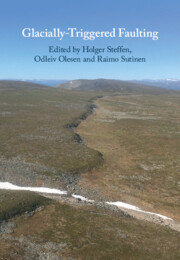Book contents
- Glacially-Triggered Faulting
- Glacially-Triggered Faulting
- Copyright page
- Contents
- Figures
- Tables
- Contributors
- Preface
- Part I Introduction
- Part II Methods and Techniques for Fault Identification and Dating
- Part III Glacially Triggered Faulting in the Fennoscandian Shield
- 10 Seismicity and Sources of Stress in Fennoscandia
- 11 Postglacial Faulting in Norway
- 12 Glacially Induced Faults in Sweden
- 13 Glacially Induced Faults in Finland
- 14 Lateglacial and Postglacial Faulting in the Russian Part of the Fennoscandian Shield
- Part IV Glacially Triggered Faulting at the Edge and in the Periphery of the Fennoscandian Shield
- Part V Glacially Triggered Faulting Outside Europe
- Part VI Modelling of Glacially Induced Faults and Stress
- Part VII Outlook
- Index
- References
13 - Glacially Induced Faults in Finland
from Part III - Glacially Triggered Faulting in the Fennoscandian Shield
Published online by Cambridge University Press: 02 December 2021
- Glacially-Triggered Faulting
- Glacially-Triggered Faulting
- Copyright page
- Contents
- Figures
- Tables
- Contributors
- Preface
- Part I Introduction
- Part II Methods and Techniques for Fault Identification and Dating
- Part III Glacially Triggered Faulting in the Fennoscandian Shield
- 10 Seismicity and Sources of Stress in Fennoscandia
- 11 Postglacial Faulting in Norway
- 12 Glacially Induced Faults in Sweden
- 13 Glacially Induced Faults in Finland
- 14 Lateglacial and Postglacial Faulting in the Russian Part of the Fennoscandian Shield
- Part IV Glacially Triggered Faulting at the Edge and in the Periphery of the Fennoscandian Shield
- Part V Glacially Triggered Faulting Outside Europe
- Part VI Modelling of Glacially Induced Faults and Stress
- Part VII Outlook
- Index
- References
Summary
The zones of glacially induced faults in Finland are portrayed by a number of discrete <10 km-long fault scarps, often forming multiple parallel segments and establishing longer glacially induced fault systems. A set of glacially induced fault systems further form glacially induced fault complexes, which may extend tens of kilometres cross-cutting glacial sediments. The systematic mapping has revealed 18 glacially induced fault systems forming 9 glacially induced fault complexes. The moment magnitude estimates for the earthquakes in Finnish Lapland are in the range of Mw ≈ 4.9–7.5. The detailed trenching across fault scarps provides evidence of non-stationary seismicity and occurrence of multiple slip events even before the Late Weichselian maximum.
Keywords
- Type
- Chapter
- Information
- Glacially-Triggered Faulting , pp. 231 - 245Publisher: Cambridge University PressPrint publication year: 2021
References
- 1
- Cited by



